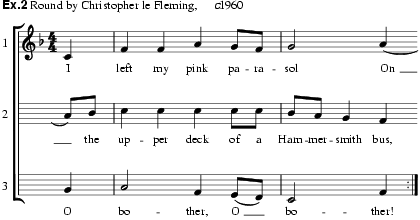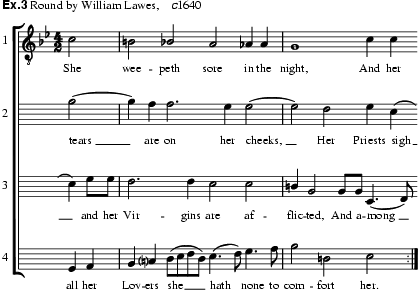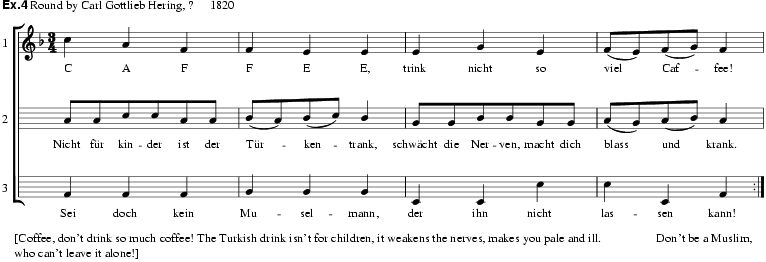
A generic term for a song consisting of a single-line melody constructed so that it forms its own harmony when sung as a canon at the unison. It is for at least three voices, which enter at equally spaced time-intervals. In performance the melody is usually repeated several times; at the end the voices may ‘tail off’, each stopping when it has completed the melody, leaving the last voice to conclude the piece alone, or they may finish together on a chord. Some rounds are designed to have accompaniments, provided by instruments or by a separate group of singers.
The essence of the round is its sense of stasis and circularity. It is a type of canon, but a limited one, since in a round the subsequent voices cannot transpose the melody's pitch, alter its rhythm or enter in an irregular time sequence. (It is a source of confusion that the German term for round is Kanon.)
The term seems to date from the early 16th century. Medieval English forms of round (such as Sumer is icumen in of about 1250) were known as Rota or Rondellus. Other terms include ‘roundel’ (as in David Melvill's manuscript Ane Buik off Roundells, made in Aberdeen in 1612), Catch (a term used to designate comic English rounds written between about 1580 and 1800), and ‘canon’ (used in 17th- and 18th- century England specifically for rounds with religious words).
Since about 1850 rounds have become the property of educationists. The advantages of rounds as teaching material are obvious: most are short and simple enough to learn by ear, so that children (and adults with limited musical knowledge) can experience partsinging without needing to grapple with a notated score; rounds taught in a foreign language make a useful introduction to another country's culture; and once practised in the classroom they are easily transportable and can be sung in less formal situations. Rounds have been particularly successful in the 20th century in England, Germany and the USA; German collections are printed in small formats, suitable to fit into students' pockets. Rounds have taken on some of the characteristics of folksongs: composers' names are usually unknown to singers (ex.1 is definitely ‘anonymous’, though only about 120 years old); some rounds have diversified through oral transmission (for example Frère Jacques now has a minor as well as a major version, and words in English and Polish as well as in the original French; ex.2 has a Scottish variant in which ‘Hammersmith’, a district in west London, has been replaced by ‘Waverley’, the railway station in Edinburgh); and when sung by mixed ensembles the different octaves are allocated among the voice lines at random, blurring the distinction between root position and inverted chords in the harmony.


This success in schools has brought artistic penalties. Educationists tend to fight shy of controversial matters, so that subjects such as politics, religion, social injustice and sex, which are the staple diet of folksongs, have become taboo in rounds. As a result, the round is now perceived as a children's art form, focussed on middle-class leisure activities and suburban trivia (ex.2), even reflecting the desire of some educators to protect children from the realities of adulthood (ex.1). Where rounds from earlier periods have survived in the modern repertory, they have usually had their words altered, or been so far removed from their original social contexts as to become almost meaningless (as is the case with those about street vendors' cries in 17th-century cities). Rounds are no longer written in modern musical styles, and remain untouched by developments in chromatic harmony, atonality, jazz idioms, serial structures and folk modes. Ex.2, though composed about 1960, might have been written in the late 18th century as far as its style is concerned.
One has only to dip into the pre-1850 repertory to realize that in earlier periods rounds had much greater intellectual muscle and social relevance. William Lawes's She weepeth sore (ex.3) is a genuine piece of religious music, whose text about the downfall of Jerusalem is taken from Lamentations; it is artfully written so that the harmony thickens and intensifies as the four tenors enter, then gradually thins out again at the end (the ‘tail off’ performance procedure is required here) to leave an image of utter desolation. Purcell's 63 known rounds are also a magnificent and varied corpus of work (see P. Hillier, ed.: The Catch Book, Oxford, 1987), and there are some fine ones ascribed to William Byrd.

C.G. Hering's round about coffee (ex.4) is an equally impressive example from the German tradition. It opens with a six-note letter motif (C–A–F–F–E–E), handled with aplomb; its counterpoint is designed to invert, so that it can successfully be sung by any vocal combination (SSS, SSB, SBB or BBB); and its subject is a delicious satire on Islamic culture, written at a time when the Turkish threat to Germany had retreated to a safe distance. Mozart's two dozen or so rounds are mainly quick sketches, though very beautiful ones, and this type of vocal counterpoint significantly informs his instrumental writing (such as in the last movement of his Quartet k575). Beethoven's rounds are mostly hasty pièces d'occasion, but that Beethoven took the form seriously is shown by his periodic excursions into round structures in his larger works, notably the quartet ‘Mir ist so wunderbar’ in Fidelio, and the first movement of his Symphony no.6 (bridge passages: bars 67–92, 346–71).

Even since 1850 rounds have made occasional appearances in large-scale classical works, for instance in Mahler's Symphony no.1 (third movement) and Britten's opera Peter Grimes (‘Old Joe has gone fishing’, finale of Act 1). It would be strange if this form, so central to Western art music for hundreds of years, were not to emerge from neglect at some time in the future.
HarrisonMMB
J. Hilton: Catch that Catch Can (London, 1652/R)
C.V. Stanford, ed.: The National Song Book (London, 1906), 229–35
G. Bantock and H.O. Anderton, eds.: The Melvill Book of Roundels (London, 1916)
F. Jöde: Der Kanon (Wolfenbüttel, 1929)
J. Stevens: ‘Rounds and Canons from an Early Tudor Songbook’, ML, xxxii (1951), 29–37
J. Vlasto: ‘An Elizabethan Anthology of Rounds’, MQ, xl (1954), 222–34
F.Ll. Harrison: ‘Rota and Rondellus in English Medieval Music’, PRMA, lxxxvi (1959–60), 98–107
C. le Fleming, ed.: Rounds and Canons for Voices and Recorders (Croydon, 1961, 2/1964)
J. Stevens, ed.: Music at the Court of Henry VIII, MB, xviii (1962)
R. Cass-Beggs, ed.: The Penguin Book of Rounds (Harmondsworth, 1982)
DAVID JOHNSON